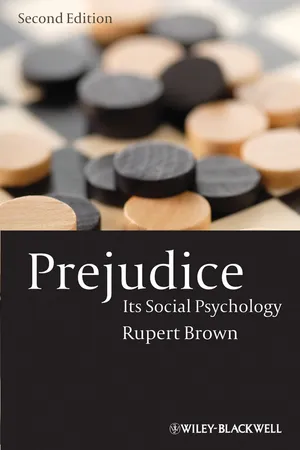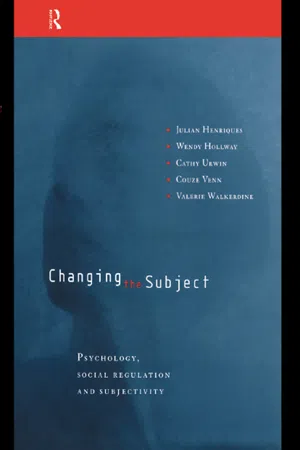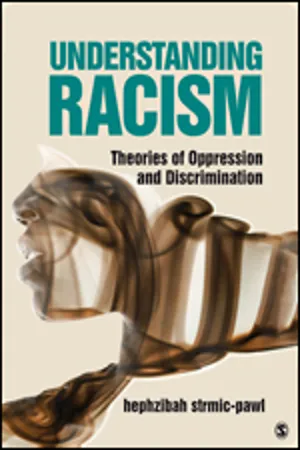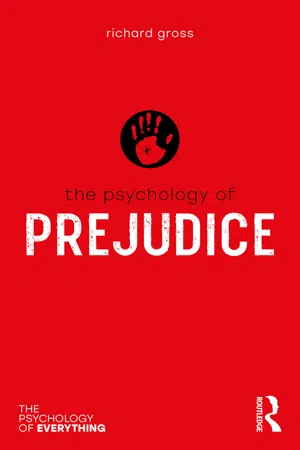Psychology
Individual Differences in Ideological Attitudes and Prejudice
Individual differences in ideological attitudes and prejudice refer to the variations in people's beliefs, values, and biases. These differences can be influenced by factors such as personality traits, socialization, and cognitive processes. Understanding these individual differences is important for addressing and reducing prejudice and discrimination in society.
Written by Perlego with AI-assistance
Related key terms
Related key terms
1 of 4
Related key terms
1 of 3
9 Key excerpts on "Individual Differences in Ideological Attitudes and Prejudice"
- eBook - ePub
Rhetoric, Ideology and Social Psychology
Essays in honour of Michael Billig
- Charles Antaki, Susan Condor, Charles Antaki, Susan Condor(Authors)
- 2014(Publication Date)
- Routledge(Publisher)
Social psychologists tend to forget, perhaps too readily, that what counts as prejudice, is more a political judgment than a psychological description (Drury, 2012). When social psychologists describe the ‘personality’ or the ‘mind-set’ of the prejudiced person they (the social psychologists) assign themselves a role. They can no longer think of themselves as individuals standing outside society and history; they are active drivers of progressive social agendas. Researching contemporary manifestations of prejudice has slowly taken social psychologists out of the laboratory and brought about an age of social consciousness, collective action and collective mobilization (Reicher, 2012a). The task of the social psychologist is to evaluate the relative weight of particular and general aspects of ideologies of prejudice, the quandaries that arise from the interplay of social and individual aspects, the nature and intensities of extreme ideologies. The question is not to explain extreme prejudice but to disentangle its pernicious presuppositions, ideological, existential and material implications. The belief that prejudices do not reflect ‘people like us’ is engrained in the common sense of societies. Prejudice (especially extreme prejudice), one tends to assume, is the preserve of people with less education, less time, less concern and empathy for the other. It is relatively easy to view prejudice in a way, which assumes that the unprejudiced are liberal and egalitarian, whereas the prejudiced are the repositories of the very opposite values (Billig, 1988c). Prejudice affects not just separate individuals, but the collective body of groups, communities and nations. Prejudices ideas, prejudiced stock of knowledge are not isolated, private aspects, they move between people, they are formulated and reformulated, resisted or internalized - eBook - ePub
- Martin Bulmer, John Solomos(Authors)
- 2013(Publication Date)
- Routledge(Publisher)
The principles of liberal, Enlightenment psychology define prejudice as a problem that occurs when people deviate from their optimal functioning as rational, human agents, consciously controlling thought and behaviour. Within this account, rationality becomes the ideal of democratic society and individuals the site where it can break down (Henriques et al., 1984). The majority of social psychologists today still follow Allport in attributing biased, faulty, irrational (that is, prejudicial) beliefs and attitudes to the distorting effects of cognitively necessary acts of prejudgement, to unwanted intrusions by emotional, unconscious, libidinal concerns into cognitive process, or to both. Allport located the cognitive, emotional and attitudinal components of prejudicial dispositions at the ‘personality level’ within his multi-layered model (also containing ‘historical’, ‘socio-cultural’, ‘situational’, ‘phenomenological’ and ‘stimulus object’ levels), and there is a current preference for converting this into an integrated account (Duckitt, 1992). However, such eclecticism merely entrenches theories which divide the individual from society with reductive effects (Henriques et al., 1984; Parker, 1989, 1992). One widely popularised approach within psychology (Dollard et al., 1939; Hovland and Sears, 1940) and beyond (see, for example, Storr, 1979), for example, explains ‘racial’ hatred as the outcome of frustrated individual needs and desires, leading to displaced or generalised aggression. Since frustration need not lead to aggression and aggression may not result from frustration (it may simply be instrumental in securing desired goals), an early reformulation proposed that a build-up of anger will be released only on the appearance of learned environmental cues (Berkowitz, 1971; 1972) - eBook - ePub
- Miles Hewstone(Author)
- 2017(Publication Date)
- Routledge(Publisher)
Be they relevant to basic personality, ideology, cognition, emotion, or rationalisation, the individual differences we have identified correlate as much (if not more) with prejudice as do traditional “situational” variables (e.g., contact). The meta-analytic effect sizes listed in Table 2 are not insignificant by any standard, with many reaching the upper bounds of associations observed in psychology (see Hemphill, 2003). Individual differences matter, particularly (but not exclusively) for predicting generalised prejudices (see Akrami et al., 2011; Onraet et al., 2015; Sibley & Duckitt, 2008)—that is, understanding why some people (relative to others) systematically dislike a host of outgroups. Moreover, generalised implicit and generalised explicit prejudices can themselves be correlated, as represented in Figure 3. That is, implicit biases towards different groups can covary (suggesting an implicit generalised prejudice factor causing their covariation), just as explicit prejudices typically covary, with the explicit and implicit latent generalised prejudices then being inter-related. In such a test, Cunningham et al. (2004) observed a correlation of.47 between implicit and explicit generalised prejudice. Such findings demonstrate that people meaningfully and systematically differ from each other in both their self-reported and more indirect, automatic biases, and in their underlying common cause (i.e., individual differences in generalised intolerance). In the same way that “personality theories have difficulty explaining how the same person can show markedly different degrees of discrimination in different situations” (Rubin & Hewstone, 2004, p. 837), theories emphasising contextual factors to the neglect of person-based factors similarly have difficulty explaining how people can differ from each other in their dislike towards different and diverse outgroups, even over time (see Zick et al., 2008) - eBook - ePub
- Miles Hewstone, Wolfgang Stroebe, Klaus Jonas, Miles Hewstone, Wolfgang Stroebe, Klaus Jonas(Authors)
- 2016(Publication Date)
- BPS Blackwell(Publisher)
Indeed, individual difference accounts may, reassuringly, help to explain why such atrocious acts remain extremely unusual – because there is something special about this individual. Nevertheless, this individual, however far from our social reality he was, clearly saw the world through a prism of ‘us and them’, involving very strong ‘ingroup’ loyalties and ‘outgroup’ enmities. Social categorization processes, social stereotypes and the identities and animosities of the intergroup level may all have played a crucial part here, and at the very least formed the setting in which his personal pathology played itself out (and indeed egalitarian societal norms against prejudice might ironically even have contributed to the force of the individual-level explanation in this case, by exacerbating a personal sense of resentment). When it comes to explaining prejudice in the modern world, it is not a case of ‘one size fits all’. In many cases we may need to draw on many levels of explanation to make full sense of prejudice, and also to explain how it can vary so widely between and within groups. We consider, first, the individual-level explanations that start us on this road. PERSONALITY APPROACHES TO PREJUDICE Is there a prejudiced personality? People differ in terms of their attitudes towards social groups. More interestingly, it seems that attitudes towards a range of social groups are often correlated: people who have negative attitudes towards one outgroup also tend to have negative attitudes towards other outgroups (Allport, 1954b). This is most evident in the case of the outright bigot, who dislikes, for example, Black people, Jews and homosexuals, three quite different groups. The generality of prejudice suggests that prejudiced beliefs may somehow be rooted within an individual’s personality - eBook - ePub
Prejudice
Its Social Psychology
- Rupert Brown(Author)
- 2011(Publication Date)
- Wiley-Blackwell(Publisher)
However, from the social psychological perspective adopted here, I believe it is more useful to regard all the phenomena encompassed by these terms as special cases of the more general phenomenon of prejudice. In this way we do not exclude from our discussion important intergroup antipathies such as class prejudice and some forms of religious bigotry, which do not have any obvious biological component. The third point is that prejudice is not to be regarded as just a cognitive or attitudinal phenomenon; it can also engage our emotions, as well as finding expression in behaviour. Thus I shall not be drawing any firm distinctions between biased attitudes, hostile feelings and discriminatory behaviour. Which is not to say that these different forms of prejudice are all identical, or are necessarily highly intercorrelated; we shall review evidence which suggests that, in fact, the relationship between them is often quite complex. But it is still possible to say that attitudes, feelings and actions are all facets of a general prejudiced orientation. This multiple-level emphasis is deliberate and stands in contrast to some trends in modern social psychology, which have tended to stress the cognitive aspects of prejudice and rather to overlook its affective and behavioural components (for example Hamilton, 1981 – but compare Mackie and Hamilton, 1993; Mackie and Smith, 2002; Smith, 1993). This cognitive analysis is undoubtedly important; indeed I shall be devoting two whole chapters to it (Chapters 3 and 4). However, to ignore the emotionally laden – one might even say saturated – nature of prejudice as it is actually perpetrated and experienced in everyday life is, it seems to me, to overlook something rather fundamental about it - eBook - ePub
Changing the Subject
Psychology, Social Regulation and Subjectivity
- Julian Henriques, Wendy Hollway, Cathy Urwin, Couze Venn, Valerie Walkerdine(Authors)
- 2003(Publication Date)
- Routledge(Publisher)
Similarly they point out that such measures ‘are concerned with the treatment of symptoms rather than the disease itself’ (ibid.). When it comes to treating the disease, they do not shy away from emphasizing ‘the true enormity of the fundamental problem’. Nor do they advocate ‘psychological means alone’: ‘the task is comparable to that of eliminating neurosis, or delinquency, or nationalism from the world. These are products of the total organisation of society and are to be changed only as that society is changed’ (ibid., p. 975). The contrast between this understanding of the problem and that of Allport’s, which, as we shall see, suggested that prejudice could be rationally corrected with the provision of accurate information, could not be starker. From the point of view of the regulation of dominant power relations Adorno was the pessimist, Allport the optimist. American instrumentality demanded both the posing of the problem and the tools for its solution to be sited in the individual so that the given social organization could be left untouched.We shall see in the following part of this chapter how Allport’s treatment of prejudice in terms of perceptual processes was more easily amenable to a translation into rational and individualistic intervention. It is Allport’s emphasis which is the forerunner of the socio-cognitive accounts of prejudice which have had the most widespread take-up in contemporary Britain.The nature of prejudice
The main impact on social psychology of Allport’s study of prejudice has been felt through its use of a social-attitudes paradigm, though his approach to the issue was considerably broader than this. Social attitudes are the psychological subject’s ideas and ways of thinking about the world; they are distinct f rom behaviours in the sense that they are regarded as the conceptual maps in the mind that determine behaviour. For instance, the behavioural manifestation of the social attitude known as prejudice is discrimination (see Ehrlich, 1973; Reeves, 1982). The study of attitudes is thus seen as a key to the understanding of behaviour. The concept of social attitudes is of particular interest here because it is seen as forming a bridge across the conceptual divide between the individual and society. Social attitudes constitute the polarity of these terms and at the same time lock them together in the way that empiricist notions of perception align subject and object (see Henriques, 1977). The investigation of the formation of attitudes and their corresponding effects on behaviour is supposed to provide insights into the information-processing mechanisms of the individual, so that we might understand how the individual processes inputs about the social world to produce specific, behavioural outputs. - eBook - ePub
Understanding Racism
Theories of Oppression and Discrimination
- Hephzibah Strmic-Pawl(Author)
- 2020(Publication Date)
- SAGE Publications, Inc(Publisher)
20Psychological Explanations
Prejudice can also be a psychological trait and is often studied via questionnaires that inquire into individual beliefs. In fact, at one point, Allport notes:Studies constitute a very strong argument for saying that prejudice is basically a trait of personality. When it takes root in a life it grows like a unit. The specific object of prejudice is more or less immaterial. What happens is that the whole inner life is affected; the hostility and fear are systematic.21There are several psychological explanations for how an individual comes to be prejudiced, including acquiring prejudice through the adoption of one’s family or reference group, participating in processes of projection, and developing a prejudiced personality. These explanations are not necessarily mutually exclusive, but each has a different focus.Individuals are often prejudiced because they have learned this prejudice from their family or other immediate reference group. Parents can foster an atmosphere of prejudice by emphasizing power and authority rather than trust and tolerance. Studies suggest that children as young as 2 and a half learn racial differences and labels before they quite understand them.22 At the first stage of prejudice development, a child learns how to generalize people into groups. Next, the child practices rejection of individuals based on group membership but may not understand this behavior. At the third stage, the child learns how to make prejudice sound rational and acceptable to society. At the last stage, around the age of 12, a child knows how to use language that sounds acceptable while practicing rejection in behavior. The irony of learning prejudice is that a young child often speaks in prejudicial terms but doesn’t believe these ideas, due to a lack of comprehension, while an older child knows how to practice discrimination while deferring to social graces. As adults, people learn to mold their prejudices to their life experiences and fit their biases to their particular needs.23 - eBook - ePub
- Todd D. Nelson, Todd D. Nelson(Authors)
- 2015(Publication Date)
- Psychology Press(Publisher)
Rowatt et al., 2006 ).This approach seems informative—we can learn about the fundamental motives of prejudice by understanding the personality variables that relate to it—indeed, our beliefs about social groups represent an essential part of our underlying political and social value orientations (Biernat, Vescio, & Theno, 1996 ; Biernat, Vescio, Theno, & Crandall, 1996 ; Jost et al., 2003 ; Schwartz, 1992 ). I think we have been better off when we think broadly about the topic, and that we can do more in this regard. The many individual difference measures naturally factor into fewer dimensions, and understanding these dimensions can help us get to the core of prejudice. Perhaps the best progress in this regard has been made by Altemeyer and his colleagues (Altemeyer, 1981 , 1988 ), who find that attitudes toward outgroups are determined in large part by two personality dimensions, indexed broadly by authoritarianism and social dominance orientation. Stangor and Leary (2006 ) found similar results—the various personality variables that we studied factored into an egalitarianism and a traditionalism dimension, and egalitarianism uniquely predicted attitudes toward outgroups, whereas traditionalism uniquely predicted attitudes toward ingroups. It will be important to continue to link our conceptualizations of intergroup attitudes to fundamental human motives, and I think there will be excellent payoffs here. On the other hand, as they frequently do, the situations in which prejudice occurs are likely to matter more than individual differences do (Murphy & Walton, 2013 - eBook - ePub
- Richard Gross(Author)
- 2020(Publication Date)
- Routledge(Publisher)
3Prejudice and personality
Psychology and personality
In modern, Western experimental psychology, the study of personality represents a major source of individual differences, other major examples being age, gender and ethnicity. An example of personality differences that has seeped into our everyday understanding of human behaviour is the introversion–extroversion dimension,1 according to which we can all be placed somewhere along this continuum; most of us will fall somewhere in the middle (we’re neither extreme introverts nor extreme extroverts).Research into introversion–extroversion and other major personality dimensions (such as neuroticism and psychoticism) has adopted a psychometric (mental measurement) approach: self-report questionnaires are used as an ‘objective’ measure of these various personality dimensions. As we saw in Chapter 2 , one of the more controversial areas of psychological research –historically but also currently – is the measurement of differences in intelligence (IQ), particularly differences between different ‘racial’ groups. Intelligence testing, like personality research, adopts a psychometric approach, and intelligence, therefore, is another major way in which people (supposedly) differ from one another. The psychometric approach has played – and continues to play – a major role in the psychological study of prejudice.A rather different approach to personality is adopted by psychologists such as Freud.2 Again, some of his ideas have found their way into everyday understanding of human nature (such as ‘ego’, ‘libido’, ‘repression’), but rather than being predominantly concerned with individual differences, he tried to describe and explain what people in general are like. For example, he believed that everyone passes through the same sequence of psychosexual stages from birth up to and including adolescence. However, people’s experiences
Index pages curate the most relevant extracts from our library of academic textbooks. They’ve been created using an in-house natural language model (NLM), each adding context and meaning to key research topics.
Explore more topic indexes
Explore more topic indexes
1 of 6
Explore more topic indexes
1 of 4








